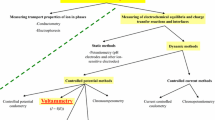Summary
Multiple standard addition techniques are commonly used with equidistant volume increments of standard addition. The disadvantage of this method is discussed in respect to data intervals in the measured potentials and to the extrapolation using Liberti-Mascini's method of evaluation. With computer-controlled instruments the standard addition is done in such a way that equidistant intervals of the potential steps to be measured are achieved. Using this method a greater working range will be obtained and the results will be more reliable because of the smaller extrapolation range and better error propagation.
Zusammenfassung
Üblicherweise wird die multiple Standard-Zumisch-Methode mit äquidistanter Reagensdosierung durchgeführt. Der Nachteil dieses Verfahrens wird anhand der Meßdaten-Dichte im Hinblick auf das Meßpotential und die notwendige Extrapolation bei der Auswertung nach Liberti-Mascini diskutiert. Mit rechnergesteuerten Systemen läßt sich die Reagensdosierung so auslegen, daß konstante Potentialschritte erreicht werden. Hierdurch wird der Arbeitsbereich vergrößert. Die Ergebnisse werden außerdem zuverlässiger, da die Extrapolation über einen kleineren Bereich erfolgt und zusätzlich eine bessere Fehlerfortpflanzung resultiert.
Similar content being viewed by others
Literatur
Becht U, Ebel S (1984) Unveröffentlichte Ergebnisse (geplante Dissertation Becht)
Brand MJD, Rechnitz GA (1970) Anal Chem 42:478–482
Buffle J, Partharasathy N, Monnier D (1972) Anal Chim Acta 59:427
Cammann K (1973) Arbeiten mit ionenselektiven Elektroden; Springer, Berlin
Clifford AA (1973) Multivariate error analysis. Appl Science Publ, London
Draper N, Smith H (1981) Applied regression analyses. Wiley & Sons, New York
Ebel S (1983) Comput Anwend Laborat 1:55–61
Ebel S, Hocke J, Reyer B (1980) Fresenius Z Anal Chem 308:437–440
Ebel S, Parzefall W (1975) Experimentelle Einführung in die Potentiometrie. Verlag Chemie, Weinheim
Garden JS, Mitchell DG, Mills WN (1980) Anal Chem 52:2310–2315
Gran G (1952) Analyst 77:661
Klockenkämper R, Bubert H (1982) Spectrochim Acta 37B:127–144
Liberti A, Mascini M (1969) Anal Chem 41:676
Moody GJ, Thomas JDR (1971) Selective ion sensitive electrodes, Merrow Publ Watford
Partharasathy N, Buffle J, Monnier D (1972) Anal Chim Acta 59:477
Reyer B (1981) Dissertation Marburg
Seuring A (1978) Dissertation Marburg
Author information
Authors and Affiliations
Rights and permissions
About this article
Cite this article
Ebel, S., Becht, U. Rechnergesteuerte multiple Standard-Zumisch-Methode beim Arbeiten mit ionensensitiven Elektroden. Z. Anal. Chem. 320, 117–120 (1985). https://doi.org/10.1007/BF00488671
Received:
Issue Date:
DOI: https://doi.org/10.1007/BF00488671




